Another reason we’d wanted to come to Villa de Leyva was to take a day to visit the weekly market in Ráquira, held only on Sundays in the pottery capital of Colombia, located 15 miles southwest of Villa de Leyva. As buses from Villa de Leyva to the town ran only at 7:45 and about noon, we missed our hotel's scrumptious breakfast so we could catch the early bus and thus be in Ráquira in time for the market. The bus was only $2 each for the 45-minute ride.
I don’t think Steven was too happy that he missed breakfast as he needs his early sustenance when we arrived in town and discovered that there was no market at all! After seeing the town square, we popped into the Cathedral built in 1690.
I loved it that all of God's children, including dogs, were welcome to join the Mass!
I thought it was cute that the bricks directly in front of the church said 'Made in Ráquira.'
The same heavy black bowls and matching basket holders were for sale in every shop.
These plaster sombrero mobiles were awfully cute but I couldn't imagine getting them home in one piece.
We saw almost no one on the dirt road except for a few guys who had had an early swim in the unnaturally green lake.
After hiking for an hour, we finally reached the small shrine, our clue to turn off the road and take the rocky path toward La Candelaria. But the directions we had were vague at best so we weren’t sure which of the three roads or paths to take. Seemed like a Robert Frost conundrum, i.e. the road less traveled! We chose the path to the left and hoped we wouldn’t have to backtrack.
I can't remember seeing so many shale rocks in umpteen years.
Our unmarked trail was not an easy one to hike on.
As we walked on, the peacefulness of the morning was interrupted by music blaring from one of the far homes. Perhaps we were being serenaded but we could have done without the noise!
Unfortunately, because of our non-Spanish skills, our guide didn't explain the lovely paintings.
Another view of the entrance to the caves:
I know she thought we were both nuts when we asked her where the town of La Candelaria was until we explained we'd hiked to the monastery directly from Ráquira and therefore hadn't come across it.
It turned out that the 'town' was just across the bridge from the monastery!
Only later did I realize this man in front of the school was also patiently waiting for a taxi. It was common in rural and small-town Colombia, by the way, for older men to wear what appeared to be a 'blanket' over their right shoulder and carry a cane. I wonder if the latter may have been to ward off the many dogs!
I bought one of the minuscule baskets this man was selling and he was so appreciative, you'd have thought I had paid $100 for it rather than the very little he'd asked.
In more ways than just the obvious, this 19th century oil entitled 'Triumph of the Virgin of Carmen' was very uplifting.
I don’t think Steven was too happy that he missed breakfast as he needs his early sustenance when we arrived in town and discovered that there was no market at all! After seeing the town square, we popped into the Cathedral built in 1690.
I loved it that all of God's children, including dogs, were welcome to join the Mass!
After Mass ended, we spent more time walking through the fascinating town square. It was sure evident that we'd come to the pottery capital even though the town looked dead as a door nail. This statue reminded me of Paul Bunyan!
The shops on the other side of the square were locked up tight.
One shop immediately beside the church was open.I thought it was cute that the bricks directly in front of the church said 'Made in Ráquira.'
We walked around as a few shops were just beginning to open up on a pleasant Sunday morning.
Since taking the Graffiti Tour in Bogota several days ago, I looked more closely at the town's street art.
Some of the shops had just huge amounts of pottery for sale.
The same heavy black bowls and matching basket holders were for sale in every shop.
These plaster sombrero mobiles were awfully cute but I couldn't imagine getting them home in one piece.
Just as these cyclists decided to head out of town, we did too since the market we had read about was a bust. We decided to hike to the tiny
hamlet of La Candelaria, set amid arid hills four miles away. It took us a
while and unfortunately many uphill steps before we figured which was the right
road to take.
It was evident that many of the ceramic items sold in Ráquira had
been made in the hills north of town.
The road ahead and
where we'd just walked.After hiking for an hour, we finally reached the small shrine, our clue to turn off the road and take the rocky path toward La Candelaria. But the directions we had were vague at best so we weren’t sure which of the three roads or paths to take. Seemed like a Robert Frost conundrum, i.e. the road less traveled! We chose the path to the left and hoped we wouldn’t have to backtrack.
If you look closely, you can just Steven in the middle of the photo on the dirt track.
Our unmarked trail was not an easy one to hike on.
The terrain changed suddenly to include ferns of all colors.
Later, our first glorious scent of pine trees since leaving Denver almost three weeks earlier.
The terrain changed again quickly to arid hills and views of
farmland in the distance.
After hiking for well over an hour, at last the path we'd taken joined up with the main road and we passed a few homes.
Once we had hit the narrow main road, there were lots of turns so we could see how easily accidents could happen.
The roadside shrine was a pleasant distraction on the long hike.
As we walked on, the peacefulness of the morning was interrupted by music blaring from one of the far homes. Perhaps we were being serenaded but we could have done without the noise!
The first signs we’d seen after hiking for close to two
hours - it was so reassuring to know we were on the right track.
At long last, we were close to reaching the Monasterio de la Candelaria,
founded in 1597 by Augustine monks and completed about 1660.
I think these were about the first flowers we'd seen since leaving Ráquira - it was an added bonus they were so pretty!
We entered the lovely church and stayed for the end of the
11 am Mass.
I was very surprised that only about 20 people in the congregation went up for Communion. I didn't realize Steven had taken this photo of me going up until later.
It wasn't until after the Mass had ended that I took this shot of the seminarian who had played guitar during Mass. We hadn't been able see him at all from where we had been sitting.
One of the most notable features in the church was the 16th century painting of the Virgen de la Candelaria over the altar.
Just like after one of the Christmas Masses at my church at
home, people immediately started filing in for the next one, anxious to get a
seat.
After paying the equivalent of $3 each, a young guide who only spoke Spanish took us on a tour of the monastery. There was one stunning courtyard after another.
The courtyards and the collection of 17th century
canvases were themselves easily worth the nominal admission fee to the
monastery.
Unfortunately, because of our non-Spanish skills, our guide didn't explain the lovely paintings.
One room contained music books from the 18th century.
Liturgical art and vestments also from the 18h century:
We followed the guide up a short incline located just a few minutes away from the church.
She told us this was the entrance to 7 caves where 12 hermits lived 500 years before the church was built. I read in a travel guide that it was men studying to be priests, however, who were forced to live in the caves for years without being able to leave.
Our guide didn't say so but the area above the steps looked like an altar to me.
We immediately followed the guide down the steps to the cave.
We've been fortunate to have been in many caves while traveling overseas the last few years. Unlike many, this one was well lit, high enough that we didn't need to stoop over and didn't seem too stuffy.
We couldn't help but being drawn to the statue of the Virgin in an alcove up ahead.
There were three ‘bedrooms’ although I use that term very
loosely indeed.
Another view of the entrance to the caves:
The large building on our right was accommodations for people who
spent time at the monastery as a retreat.
Even though we didn't learn as much as I would have liked because of the language barrier, our tour of the Monastery had been rewarding.I know she thought we were both nuts when we asked her where the town of La Candelaria was until we explained we'd hiked to the monastery directly from Ráquira and therefore hadn't come across it.
It turned out that the 'town' was just across the bridge from the monastery!
La Candelaria was truly a one-horse town if there ever was
one! It was so tiny, I'm not even sure it qualified as a hamlet as there was only the one shop on the left, a bar that was for sale on the right, a school to my left where I was standing and a couple of homes. That was it!
Only later did I realize this man in front of the school was also patiently waiting for a taxi. It was common in rural and small-town Colombia, by the way, for older men to wear what appeared to be a 'blanket' over their right shoulder and carry a cane. I wonder if the latter may have been to ward off the many dogs!
The taxi driver had just dropped off these people.
Did you think I was joking about La Candelaria being a
one-horse town?!
Since there wasn’t much need for more than the occasional
taxi, our driver also took two other men and a boy in the open trunk area with
us back to Ráquira.
We got back in time to see how hopping the town was on a
Sunday and that our travel guide hadn’t been wrong after all about the Sunday
‘market.’ We had just misinterpreted what it meant by the word 'market.'
Brightly painted facades and a jumble of craft shops with stacks of freshly-fired mud and clay pots made a welcoming sight along the main street. There were also dozens of open craft shops around the main square which sold pretty much the same stuff including hammocks, baskets, bags, ponchos, jewelry and wood carvings.
It was fun to see how the town had come alive in the few hours since we had first arrived expecting to see the 'market'!
After wandering in and out of the shops on the square, we
got a ‘collectivo’ or minivan back to Villa de Leyva about 3ish.
We headed straight to the Museo de Arte Religioso del Carmen, one of the best museums of religious art in the
country.
The museum was opened in 1971 when the friars of the Community of Barefoot Carmelites, a religious order founded in the 12th century, decided to publicly exhibit various works of religious art. Not only was the admission free but each visitor was also
given a small booklet which included photos of several of the museum’s
masterpieces. It was fun trying to search out the originals but it was harder
than we’d have thought because the color of the photos was markedly different
than the original paintings.
A 17th century genealogical tapestry:
This 18th century oil on canvas painting was titled 'St. Theresa Writing.'In more ways than just the obvious, this 19th century oil entitled 'Triumph of the Virgin of Carmen' was very uplifting.
This Roman Missal from 1806 was remarkably left open for anyone to turn to any page and not kept under a glass case as I would have expected.
The 1845 oil on canvas painting of Christ descending from the cross was done in Quito, Ecuador.
Religious music, which played softly in the background as we moved from room to room in the small museum, was the perfect complement to the beautiful works of art.
Our day ended that night as had the previous one with our walking across Plaza Mayor. We didn't realize until later it was to be, sadly, our last view of the delightful colonial square. Even though our 'mission' or goal when we set out that morning had been to just visit Ráquira, that turned out to be a anticlimactic compared to the far more exciting hike and discovery of the La Candelaria Monastery.
Next post: Tunja: Never on a Monday!
Posted on October 5th, 2017, from Guayaquil, Ecuador.












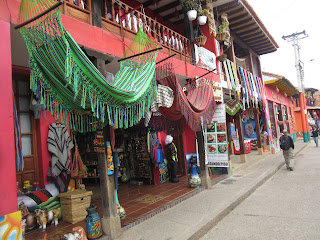

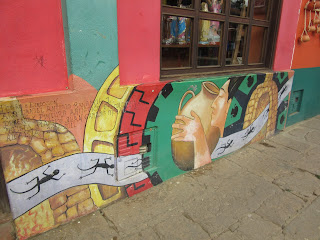






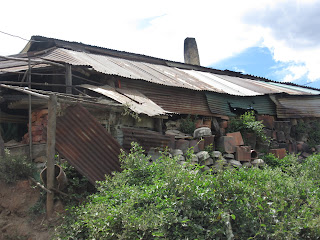









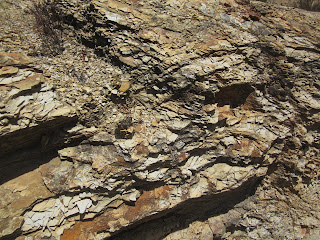



















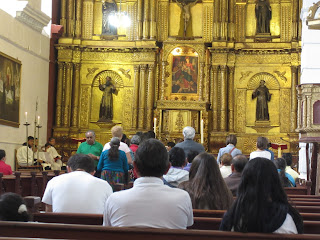




















































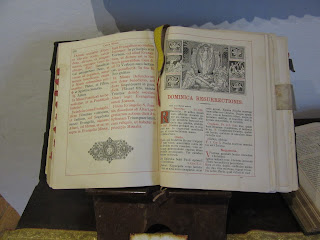

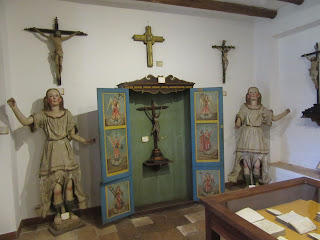





No comments:
Post a Comment